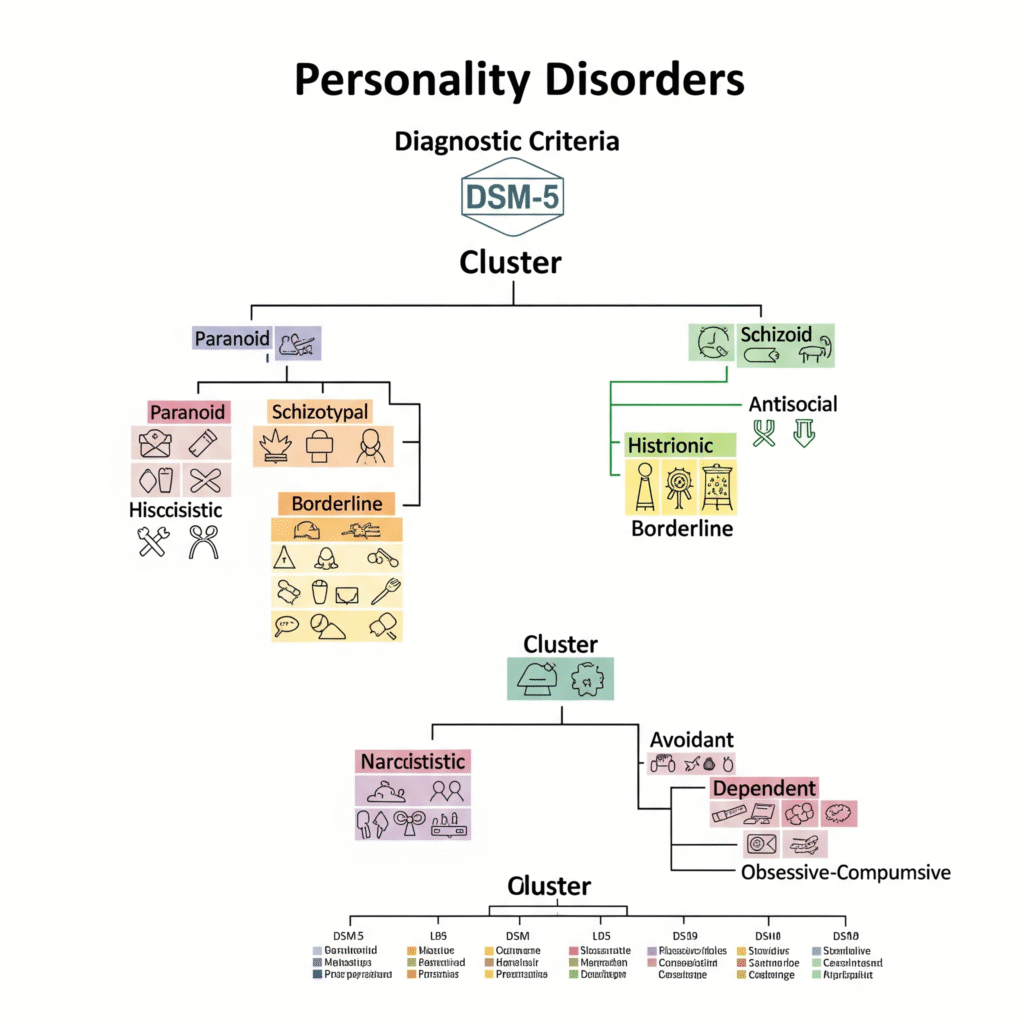What Are Personality Disorders?
Personality disorders are enduring patterns of thinking, feeling, behaving, and relating to others that significantly deviate from cultural expectations and lead to distress or impairment.
These patterns typically:
- Begin in adolescence or early adulthood
- Are inflexible and pervasive across situations
- Cause significant interpersonal, social, or occupational problems
Unlike mood or anxiety disorders, personality disorders are deeply ingrained traits, not temporary states.
Personality Disorders in the DSM-5
The DSM-5 (Diagnostic and Statistical Manual of Mental Disorders, 5th Edition) classifies personality disorders under Section II and groups them into three clusters (A, B, and C), based on similar characteristics.
There are 10 officially recognized personality disorders in the standard model, and an alternative hybrid model introduced in Section III for further study.
The Three Clusters of Personality Disorders
Cluster A: Odd or Eccentric Disorders
These disorders involve disrupted thinking patterns and social detachment.
- Paranoid Personality Disorder
- Pervasive distrust and suspicion of others.
- Schizoid Personality Disorder
- Detachment from social relationships and limited emotional expression.
- Schizotypal Personality Disorder
- Eccentric behavior, cognitive or perceptual distortions, and discomfort in close relationships.
Cluster B: Dramatic, Emotional, or Erratic Disorders
Marked by emotional dysregulation and impulse control issues.
- Antisocial Personality Disorder
- Disregard for and violation of the rights of others. Often linked with criminal behavior.
- Borderline Personality Disorder
- Instability in emotions, relationships, self-image, and behavior.
- Histrionic Personality Disorder
- Excessive emotionality and attention-seeking behavior.
- Narcissistic Personality Disorder
- Grandiosity, need for admiration, and lack of empathy.
Cluster C: Anxious or Fearful Disorders
Characterized by high levels of anxiety or fearfulness.
- Avoidant Personality Disorder
- Extreme social inhibition, feelings of inadequacy, and hypersensitivity to criticism.
- Dependent Personality Disorder
- Submissive and clinging behavior, and fear of separation.
- Obsessive-Compulsive Personality Disorder (OCPD)
- Preoccupation with orderliness, perfectionism, and control (not the same as OCD).
DSM-5 Diagnostic Criteria for Personality Disorders
To meet the diagnostic threshold, an individual’s personality traits must be:
- Persistent and inflexible across many life situations
- Deviant from cultural norms in cognition, affectivity, interpersonal functioning, or impulse control
- Distressing or impairing in social, occupational, or other key areas
- Stable and long in duration, often dating back to adolescence
- Not better explained by another mental disorder, substance use, or medical condition
Clinicians use structured interviews, clinical observation, and psychometric tools to assess these traits.
Alternative DSM-5 Model for Personality Disorders
In Section III of the DSM-5, an Alternative Model for Personality Disorders (AMPD) is presented. This model includes:
Levels of Personality Functioning
- Identity
- Self-direction
- Empathy
- Intimacy
Pathological Personality Traits
- Negative Affectivity
- Detachment
- Antagonism
- Disinhibition
- Psychoticism
This dimensional model allows for greater clinical flexibility and precision, especially in complex or overlapping cases.













